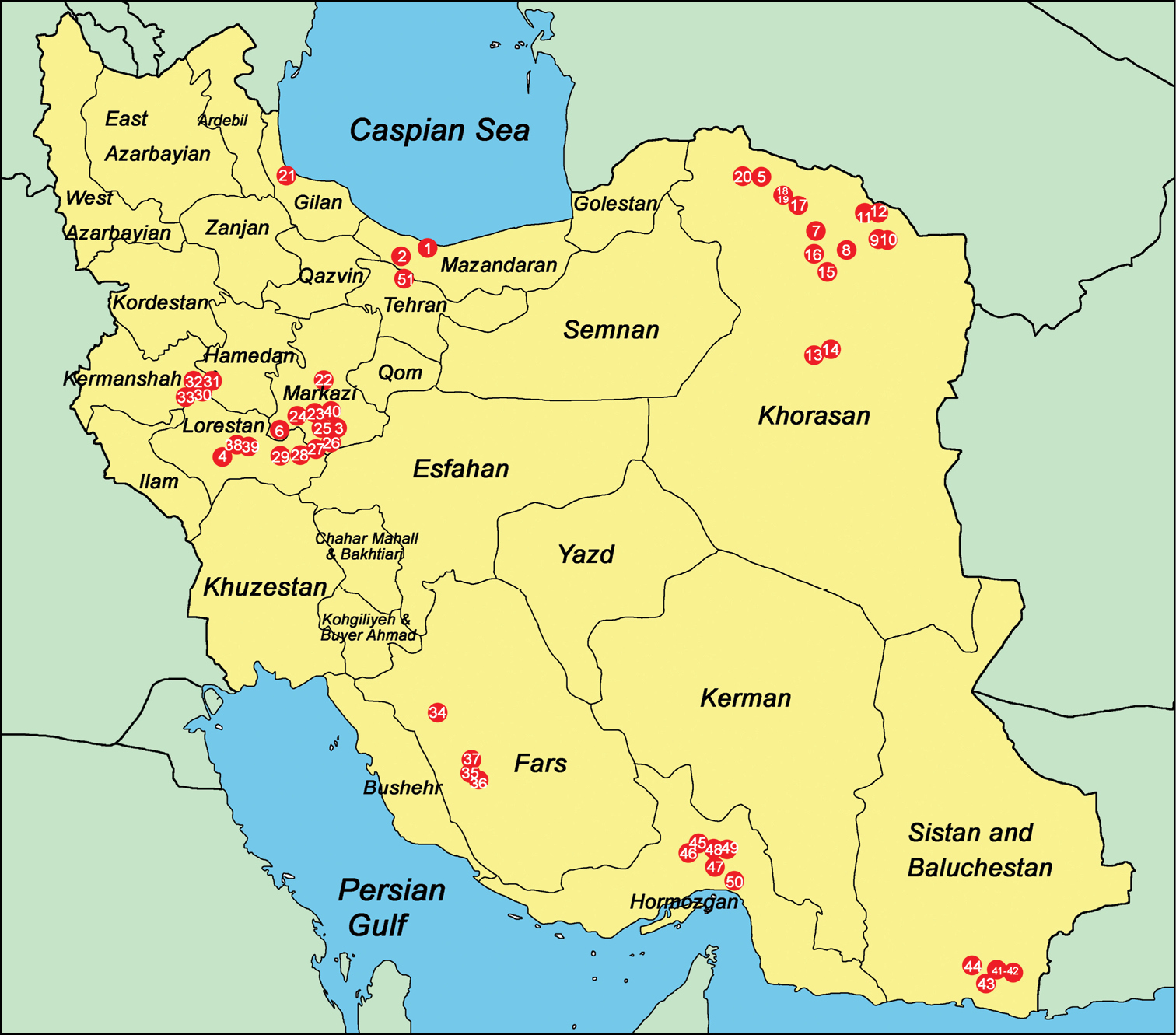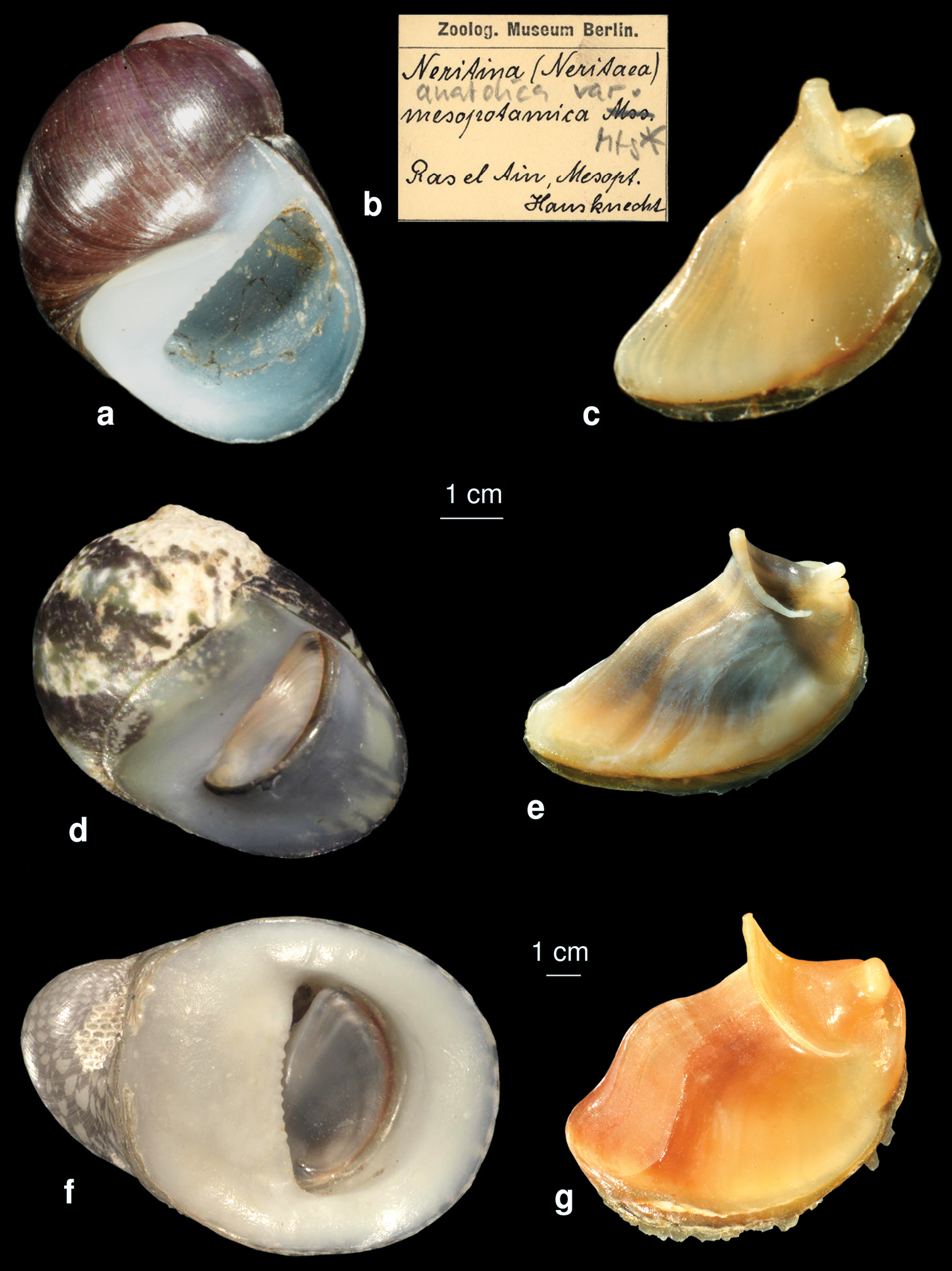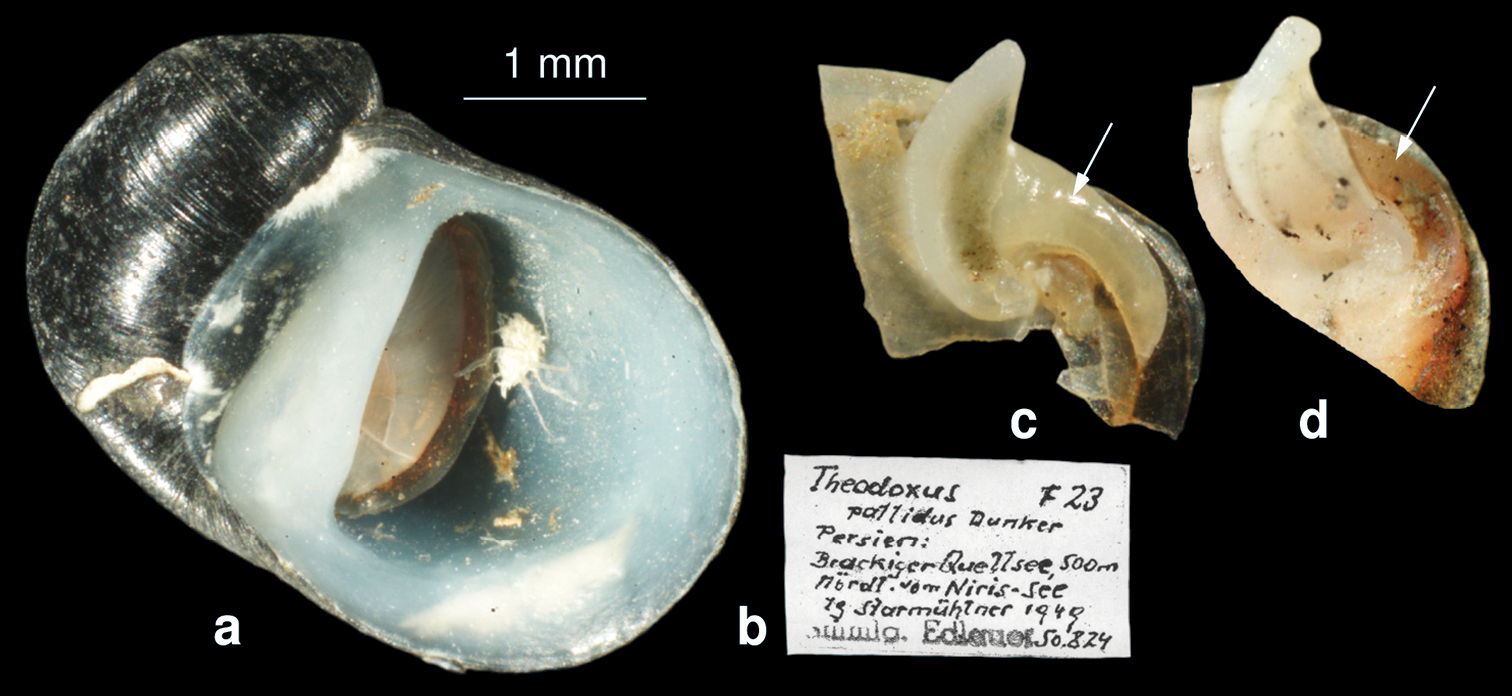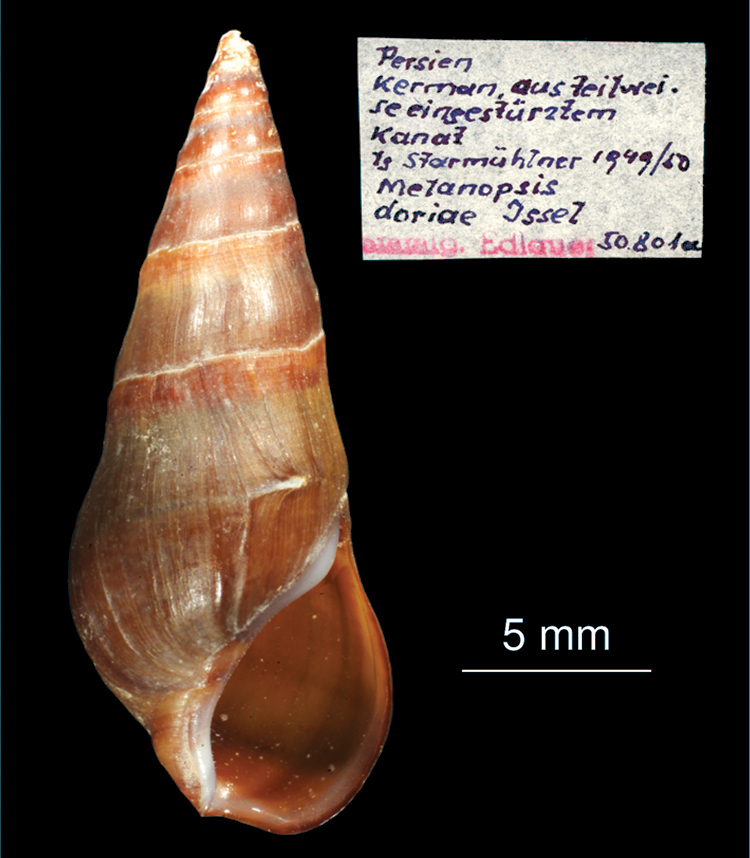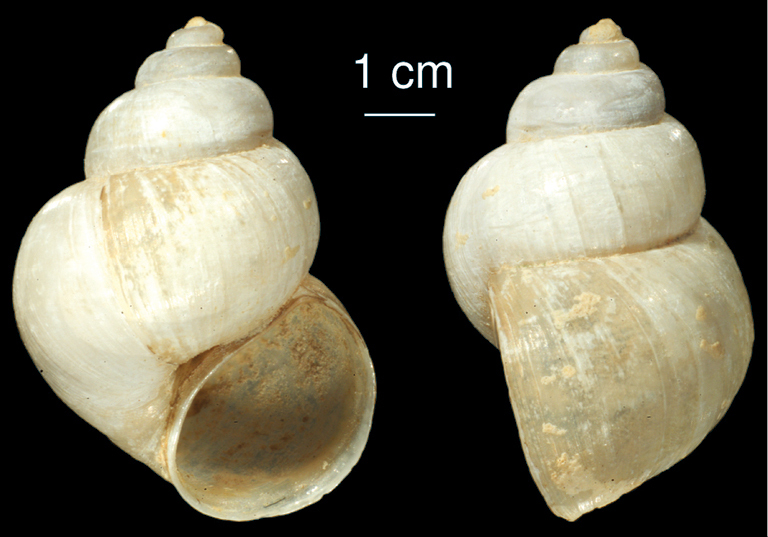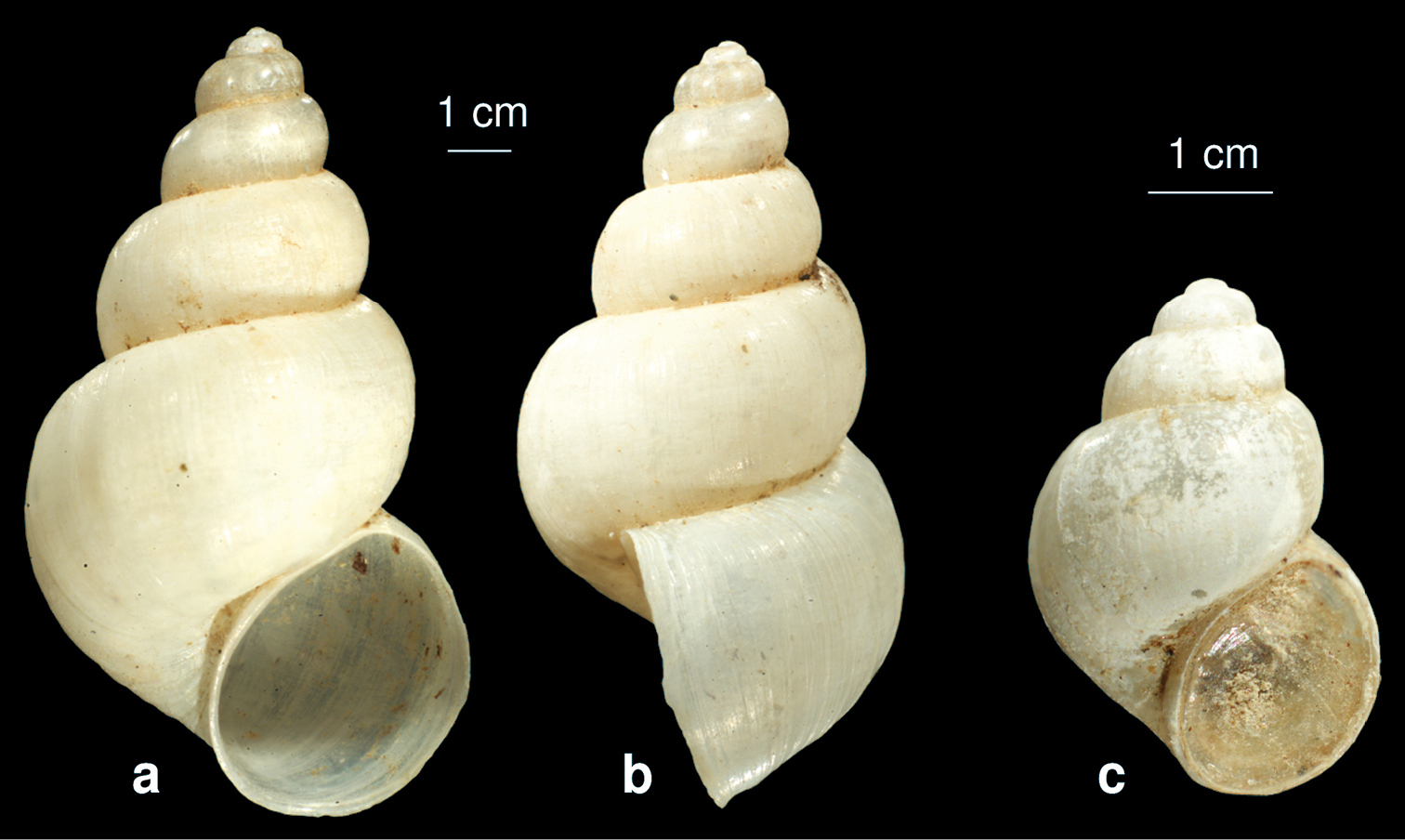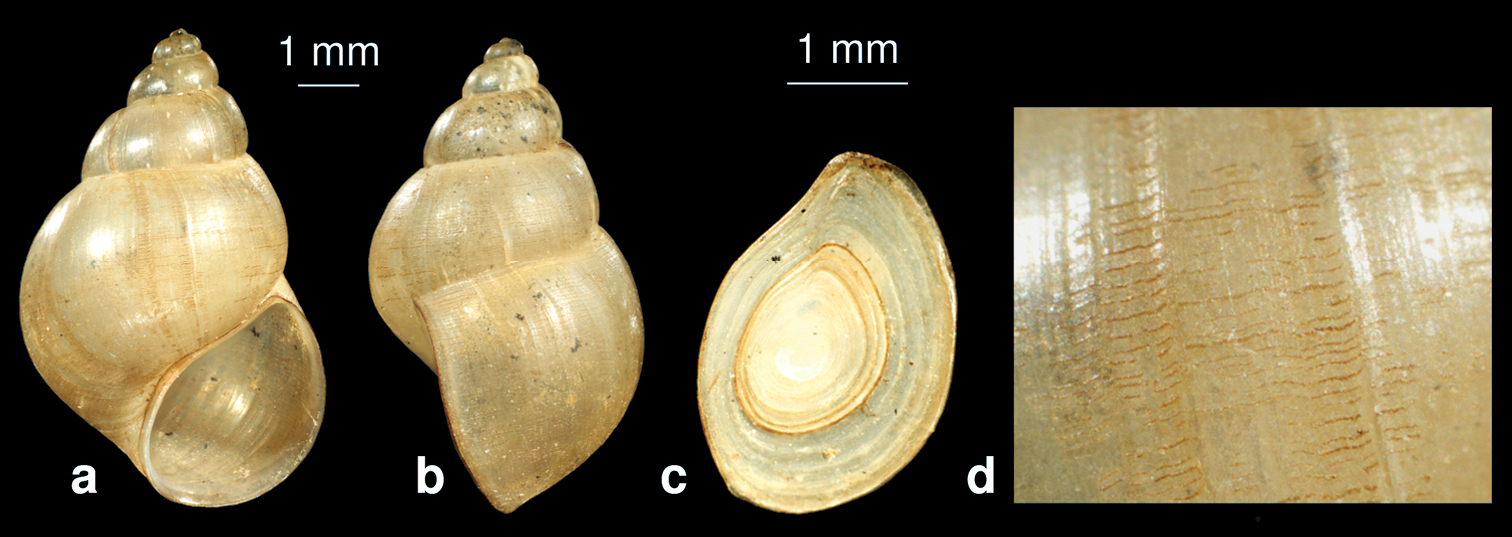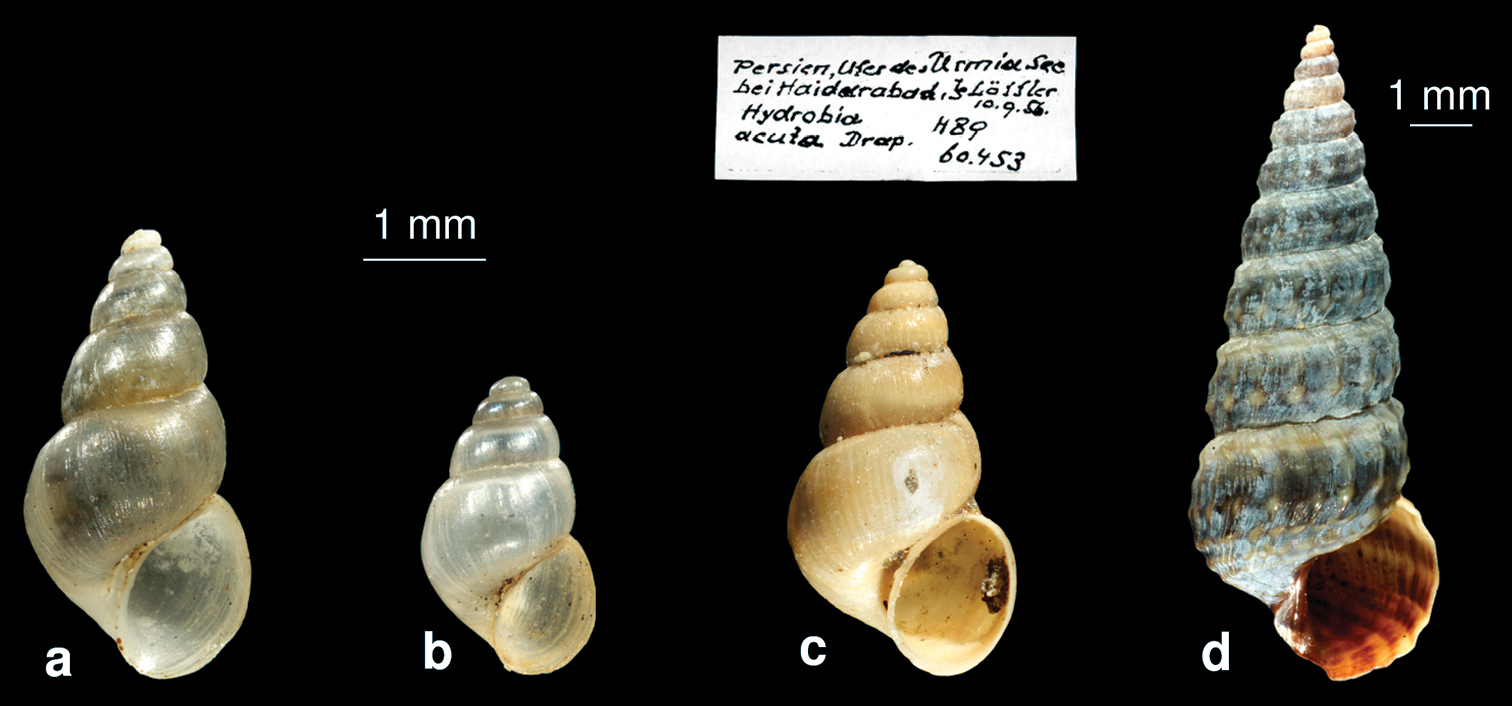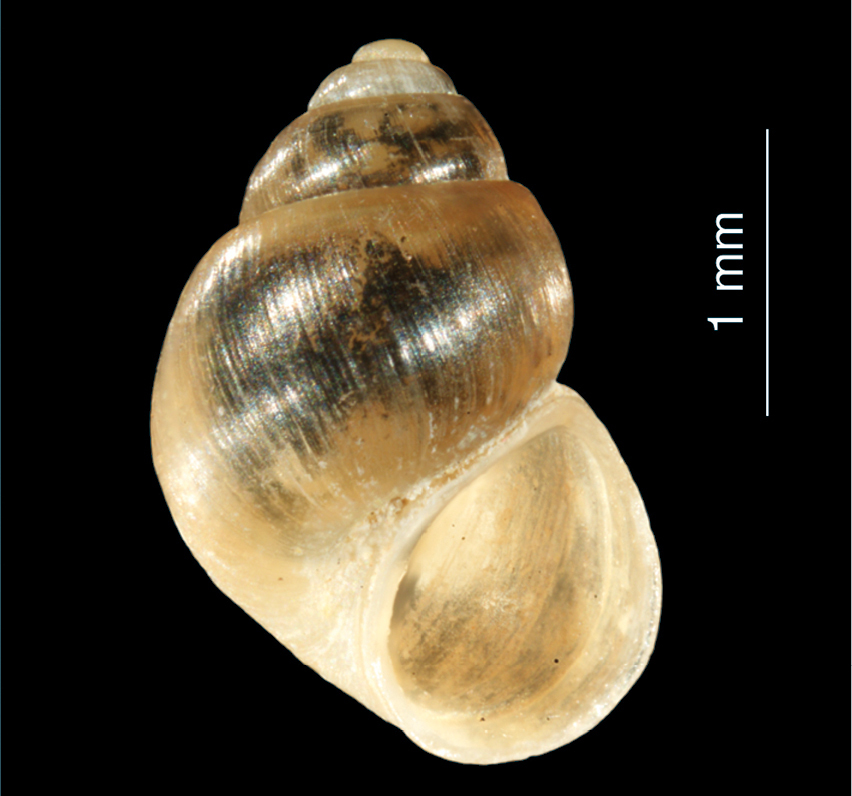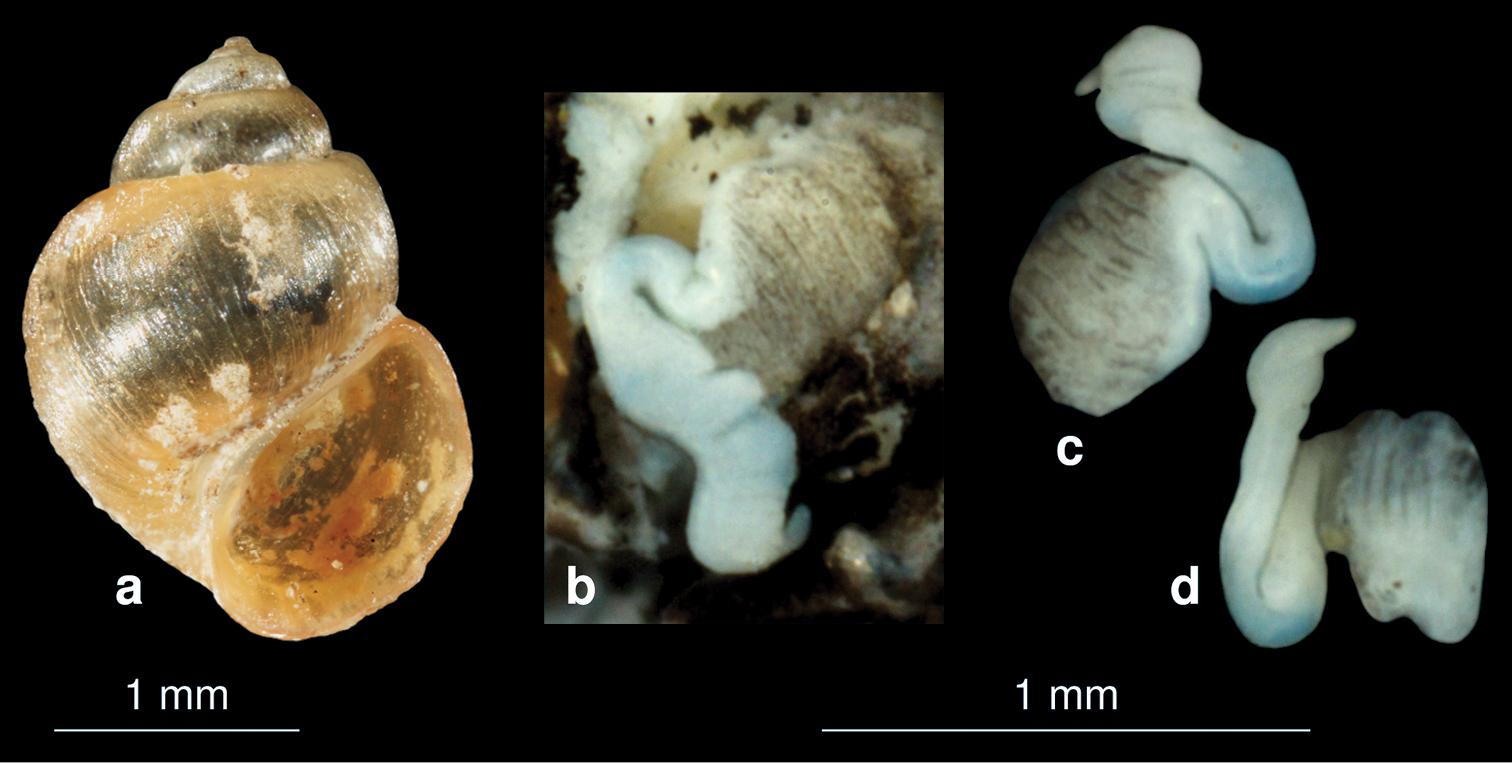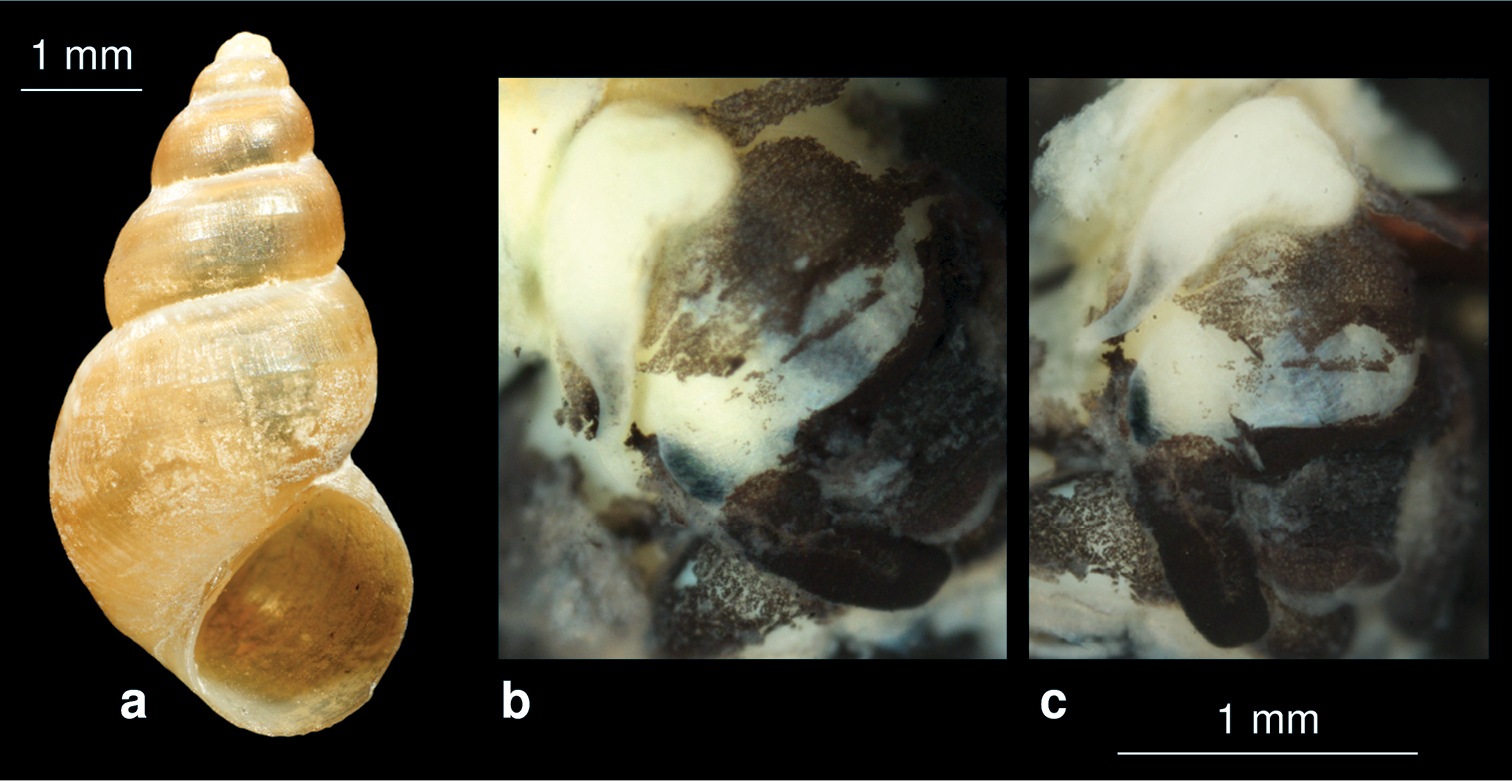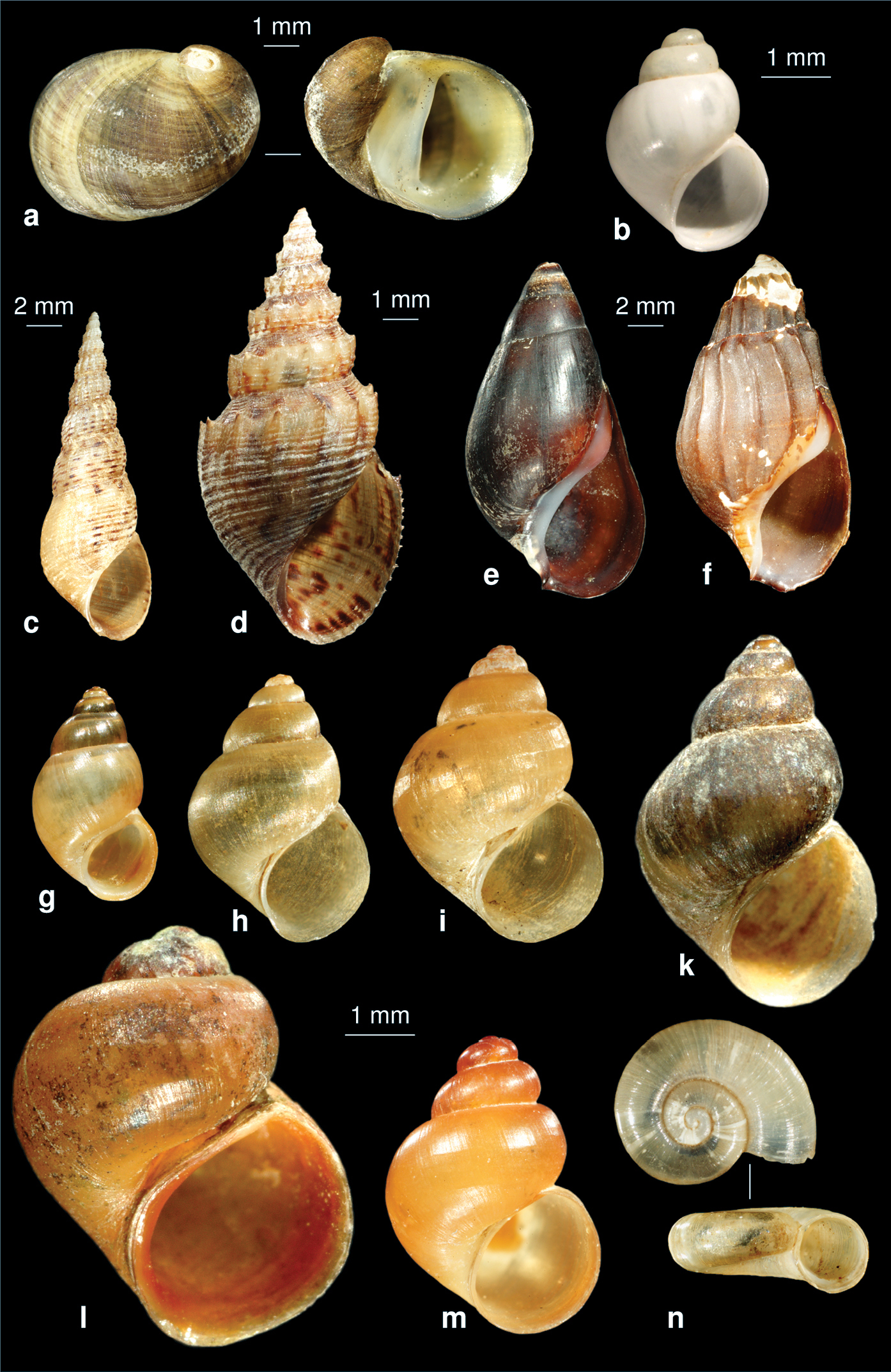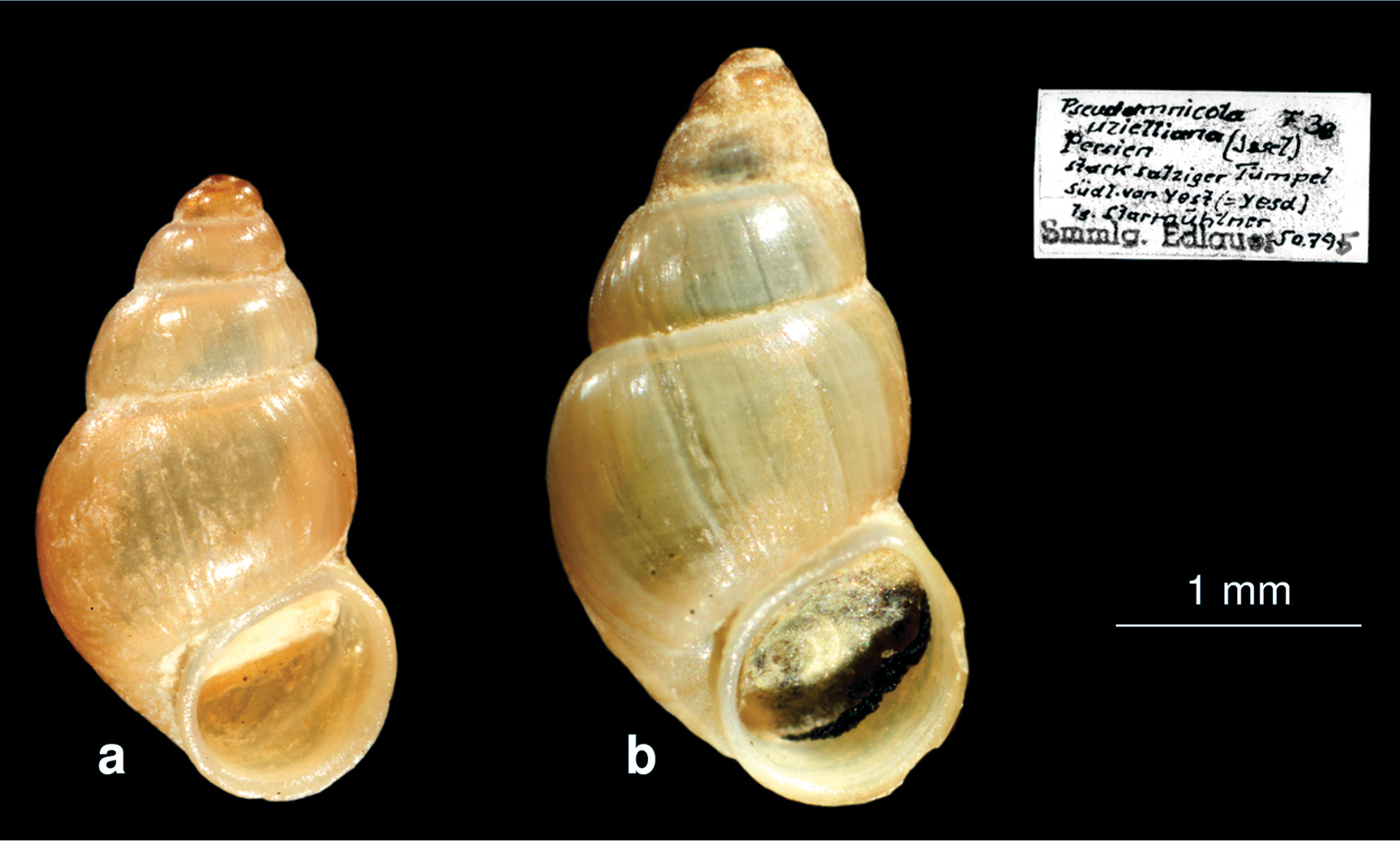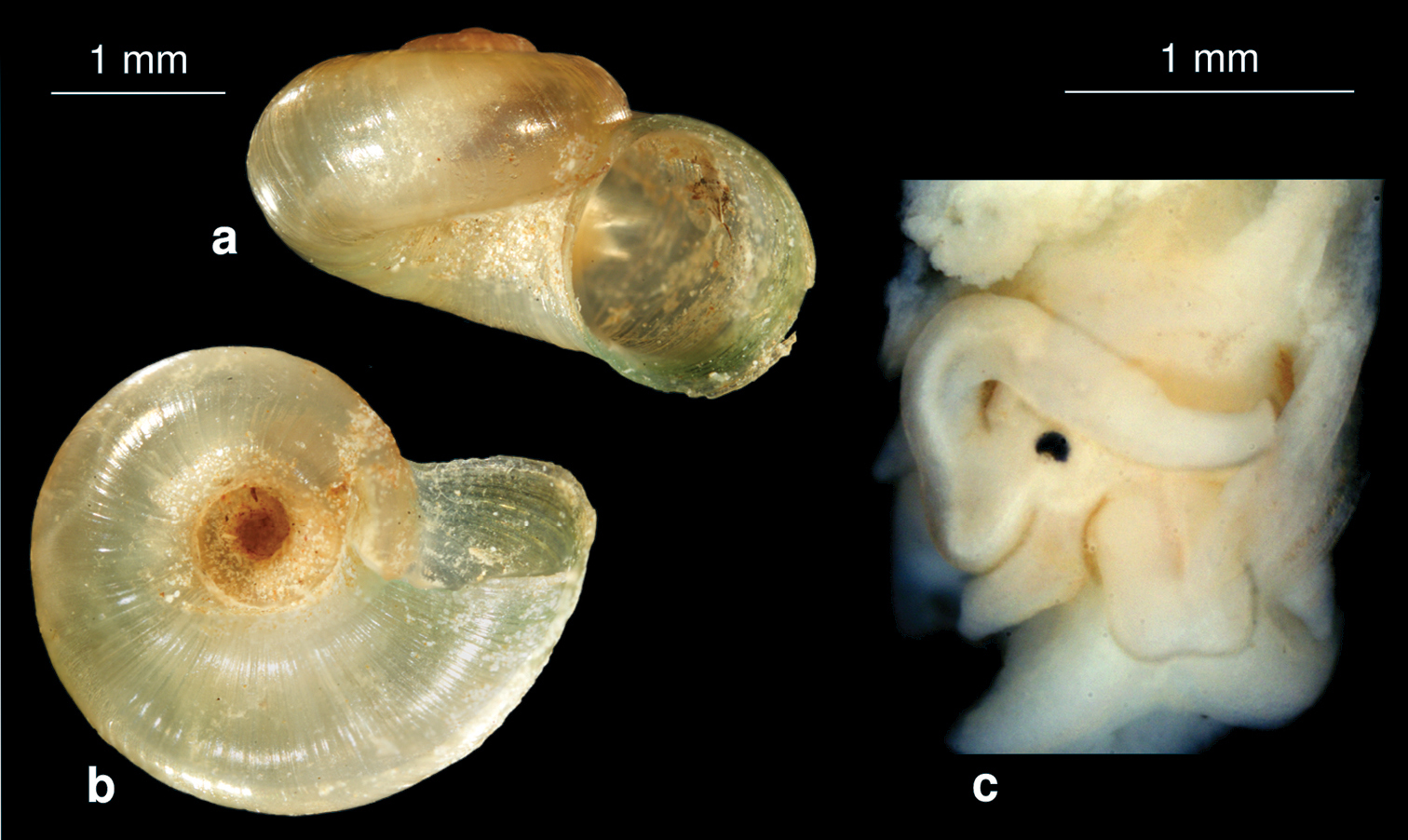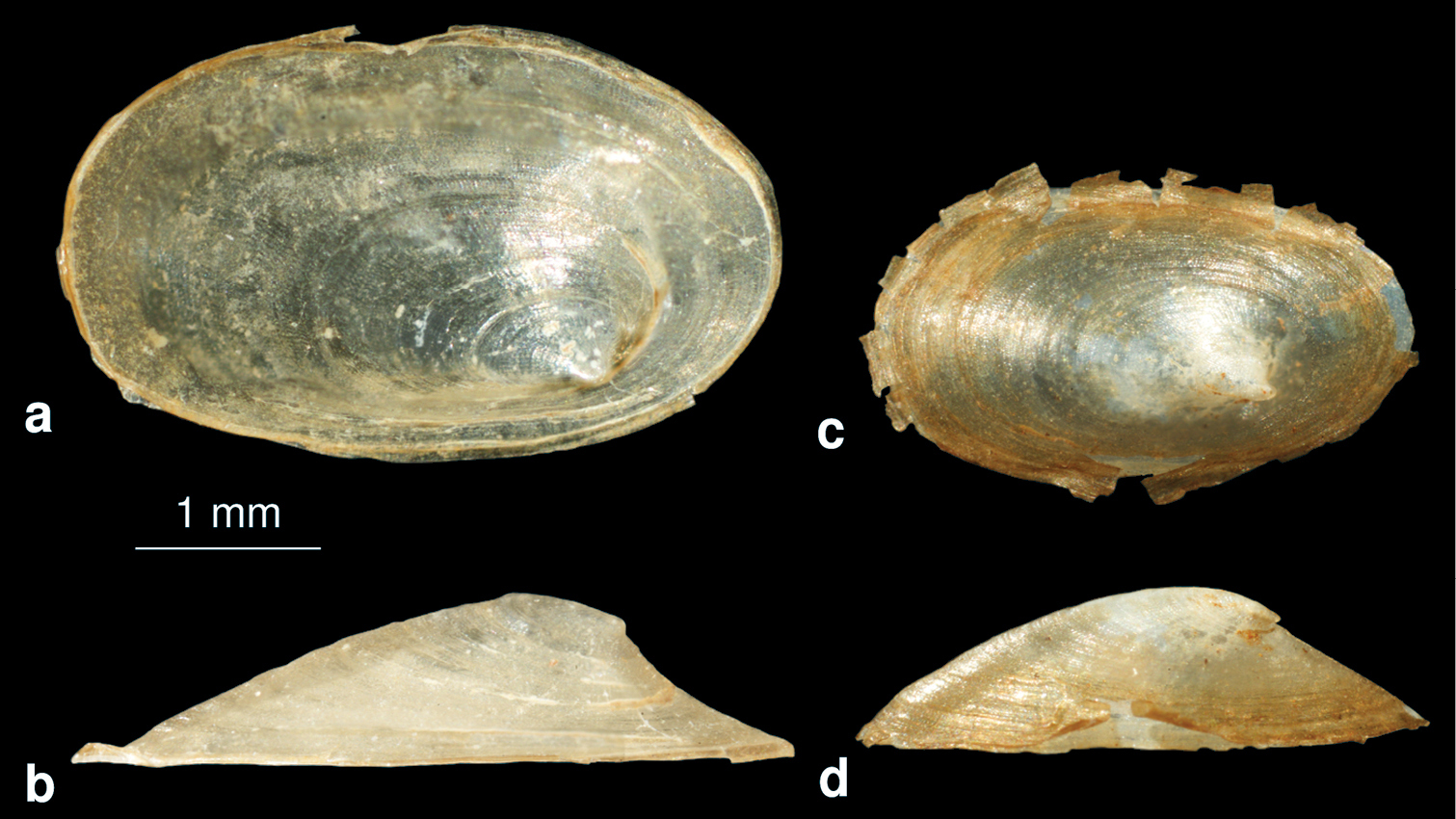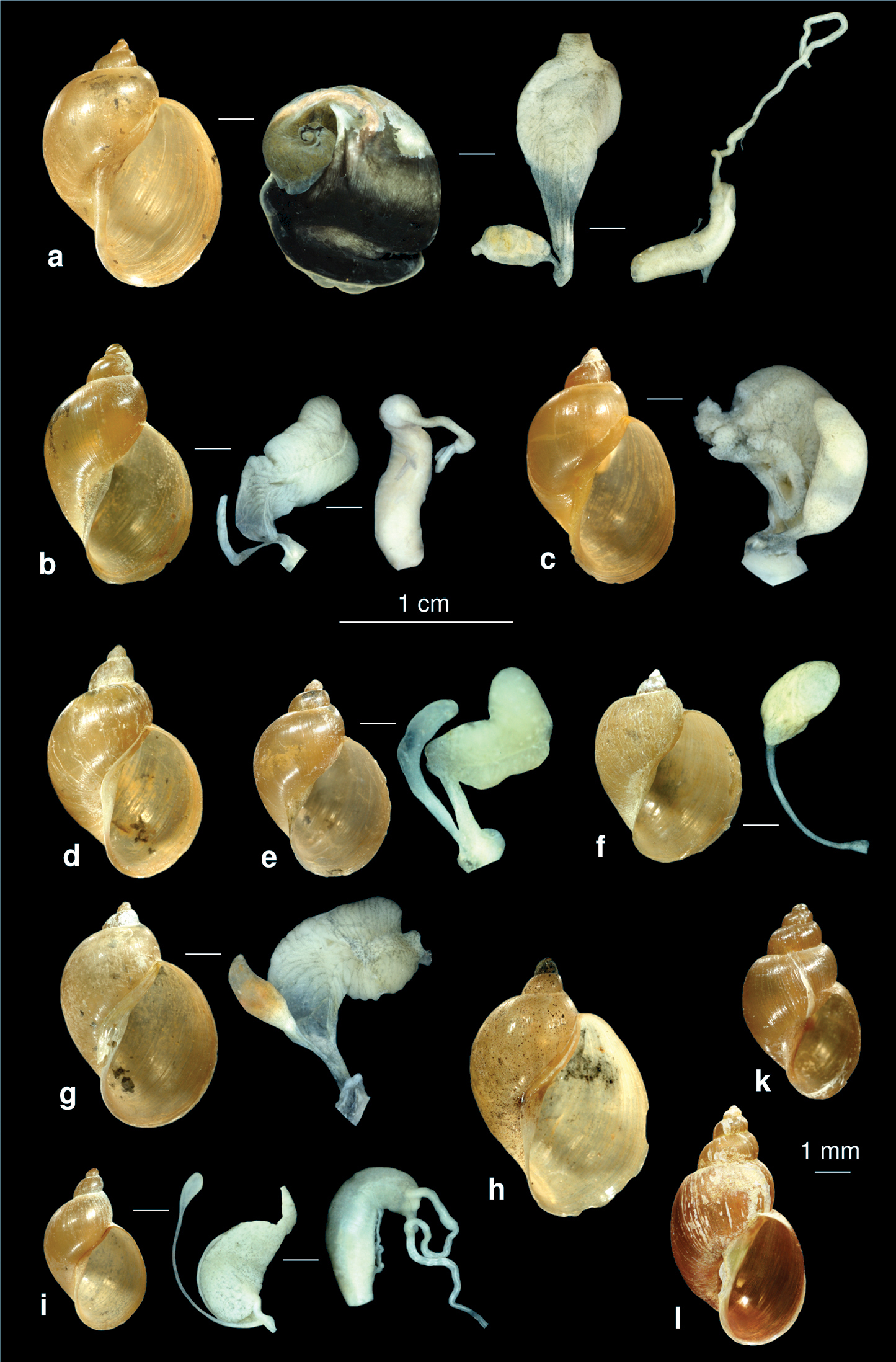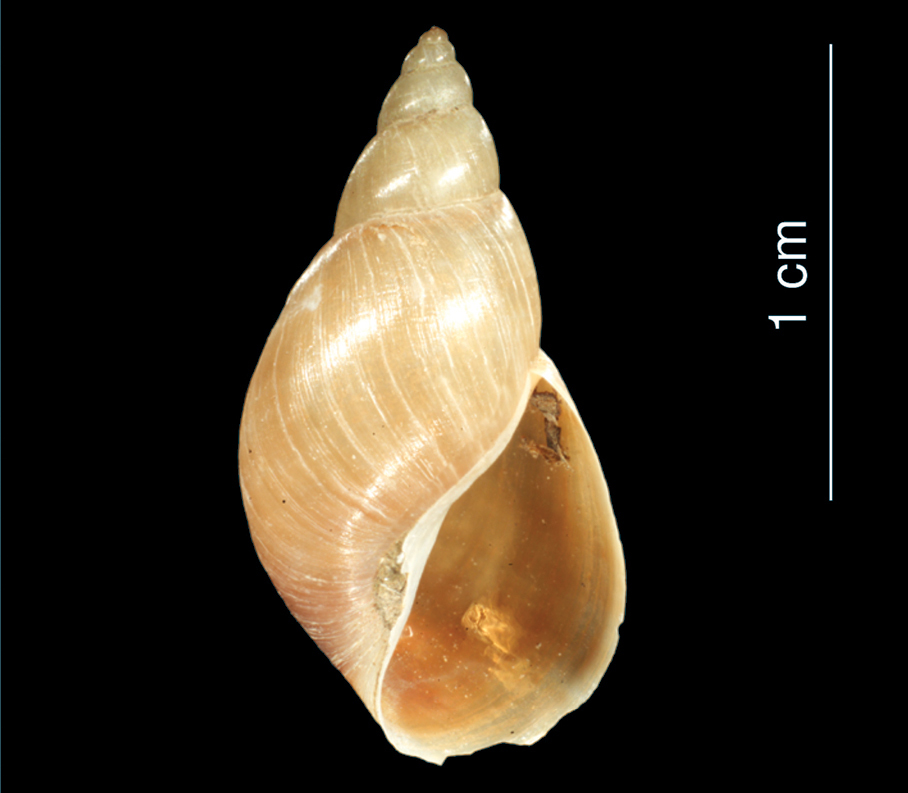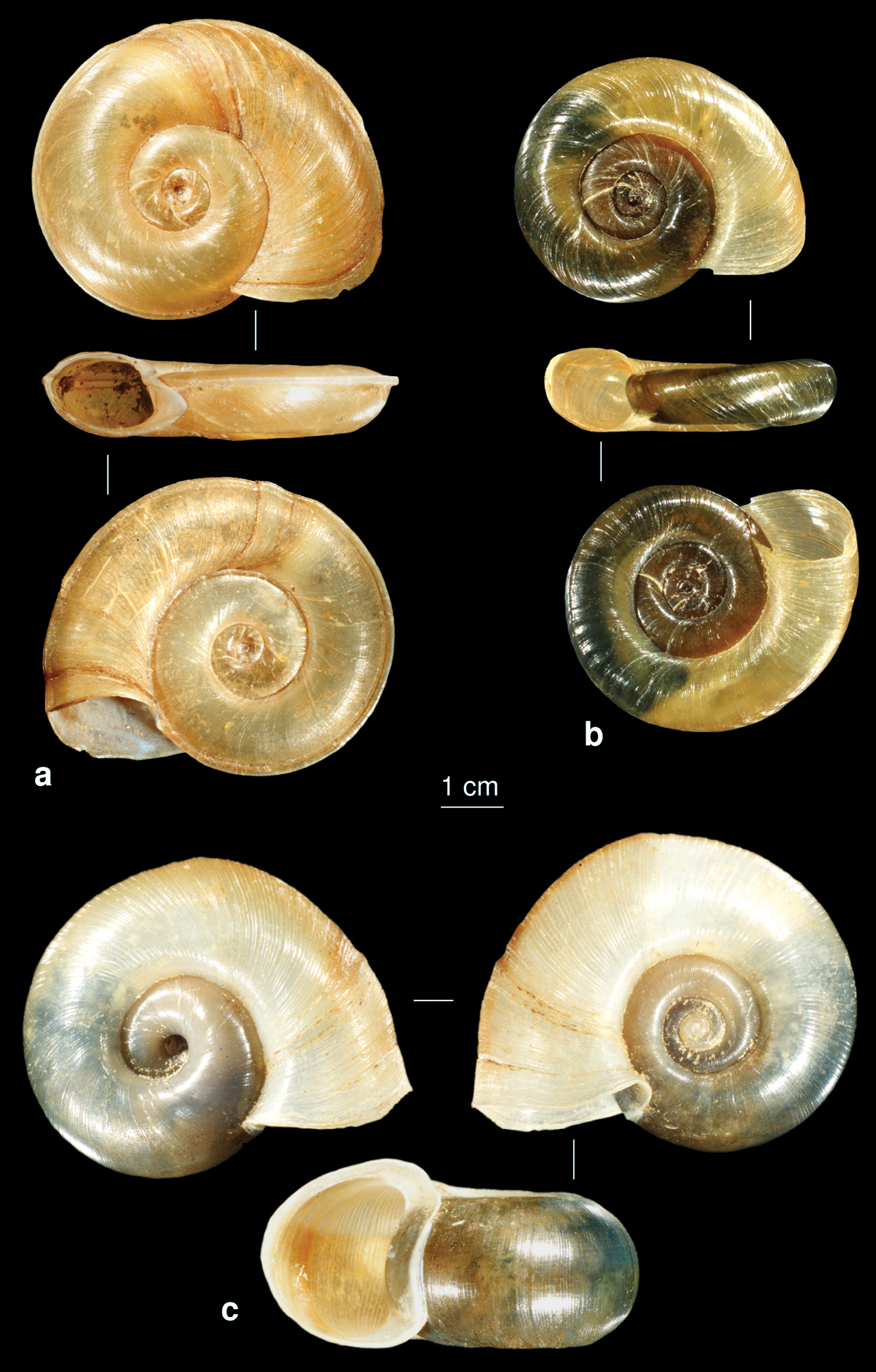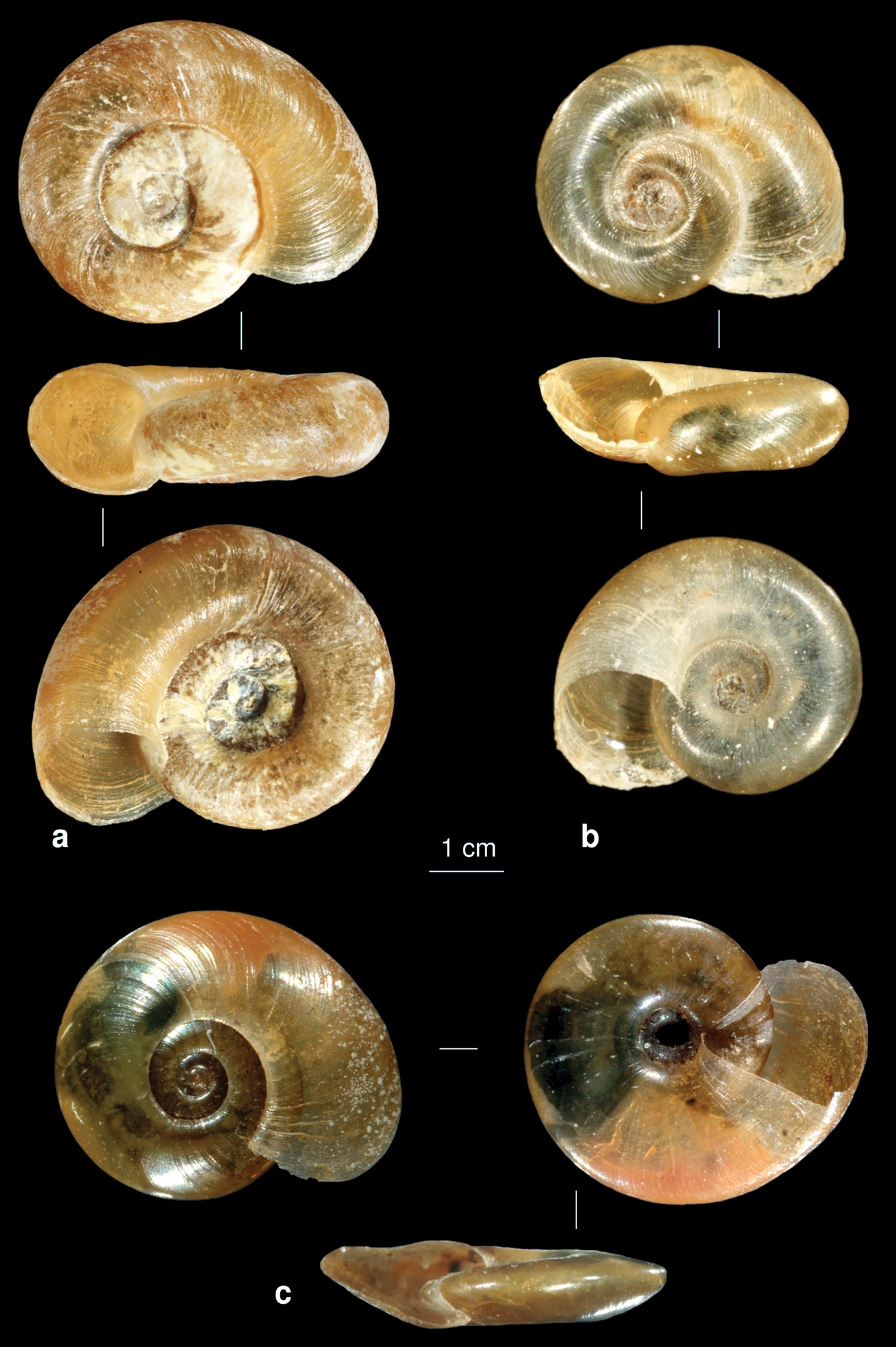






(C) 2012 Peter Glöer. This is an open access article distributed under the terms of the Creative Commons Attribution License 3.0 (CC-BY), which permits unrestricted use, distribution, and reproduction in any medium, provided the original author and source are credited.
For reference, use of the paginated PDF or printed version of this article is recommended.
Using published records and original data from recent field work and revision of Iranian material of certain species deposited in the collections of the Natural History Museum Basel, the Zoological Museum Berlin, and Natural History Museum Vienna, a checklist of the freshwater gastropod fauna of Iran was compiled. This checklist contains 73 species from 34 genera and 14 families of freshwater snails; 27 of these species (37%) are endemic to Iran. Two new genera, Kaskakia and Sarkhia, and eight species, i.e., Bithynia forcarti, Bithynia starmuehlneri, Bithynia mazandaranensis, Pseudamnicola georgievi, Kaskakia khorrasanensis, Sarkhia sarabensis, Valvata nowsharensis and Acroloxus pseudolacustris are described as new to science; Ecrobia grimmi (Clessin & Dybowski, 1888), Heleobia dalmatica (Radoman, 1974) and Hippeutis complanatus (Linnaeus, 1758) are reported for the first time from Iran. Additional field work is highly desirable for a more appropriate evaluation of the extant freshwater snail biodiversity in Iran.
Freshwater snails, checklist, new species, Iran
Considering the geographical position of Iran, a rich fauna of freshwater snails could be expected. A high level of endemism and a diverse mixture of Palaearctic and Paleotropical elements are characteristic of the Iranian freshwater fauna (
Research of molluscs biodiversity in Iran has a relatively long tradition. In 1862, a group of Italian scientists undertook the first systematic expedition to Persia, which revealed a large number of molluscan samples. The results of this expedition have been published by
However, our knowledge of freshwater snails of Iran remains scanty. Despite a growing number of data over the last years, resulting from the expeditions of the junior author in 2005, 2007, and 2011, literature records of freshwater snails in Iran have remained scattered and unreviewed, hampering ecological and biogeographical analysis. To what extent is the area of Iran unique and important for freshwater snail biodiversity? This paper attempts to answer such questions by compiling data on water molluscs and their current geographic distribution in Iran.
Material and methodsThe checklist of the freshwater snail fauna of Iran was compiled using published records and original data. The data from all publications were brought to the presently accepted state of taxonomy following
During the field work, freshwater snails were collected by hand netting, sorted on the spot and preserved in 75 % alcohol. The data and locations of the sampling sites, where the junior author collected in 2005, 2007 and 2011 are listed in Appendix 1. In the section ‘New records’ collecting site abbreviations derive from the geographical database Pešić. The type material will be deposited in the Zoological Museum Hamburg (ZMH), Germany. Further, we had the opportunity to revise material of some Iranian freshwater snails deposited in the collections of the Natural History Museum Basel (NMB – Forcart’s collection), Zoological Museum Berlin (ZMB) and Natural History Museum Vienna (NHMW – Edlauer’s collection).
Not all species could be identified due to the sparsity of specimens and the non-characteristic shells, especially of small hydrobioid snails. Furthermore, the Caspian Sea fauna is not considered in the present paper. The order of families follows
Map of Iran with dots showing the collection localities (corresponding to the sampling site numbers in Appendix). The total number of freshwater mollusc species collected from each province are as follows (in parentheses): Bushehr (1), Fars (15), Gilan (12), Hormozgan (13), Isfahan (10), Kerman (15), Hermanshah (4), Khorasan (5), Khuzestan (14), Lorestan (6), Markazi (5), Mazandaran (21), Qom (1), Seistan and Baluchestan (16), Semnan (1), Teheran (5), West Azarbayjan (1), Yazd (6), Zanjan (1).
Theodoxus and Neritina are distinguished from each other by their ontogeny (
Type species. Nerita pulligera Linnaeus, 1758
Khuzestan Province (
Zoological Museum Berlin (ZMB), “Neritina (Neritaea) anatolica var. mesopotamica, Ras el Ain, Mesopot. Hausknecht”.
The height of the largest shell of the examined syntypes from Zoological Museum Berlin was 7 mm.
Iraq, Iran (Khuzestan).
a–c Neritina mesopotamica d–e Neritina euphratica f–g Neritina schlaeflii a shell (syntype) b lable c operculum d shell (syntype, ZMZ 528916, Irak, Samava, photo: Eike Neubert) e operculum of Neritina euphratica from Euphrates f shell (syntype, ZMZ 529679, Persian Gulf, Island Ghaes, photo: Eike Neubert) g operculum of Neritina schlaeflii from Shatt Al-Arab-Fao region.
http://species-id.net/wiki/Neritina_cinctellus
Khuzestan Province (
Remark. According to the original description (
Iraq, Iran.
Khuzestan Province (
This speciesis characterized by a small shell with 6 mm in height and a small spire. The boder of the columella is straight and not denticulated. The operculum has a rib which is attenuated at its basis, the peg is thick and strong and split in two parts (fig. 2e).
Iraq, Iran.
Type species. Nerita fluviatilis Linnaeus, 1758
http://species-id.net/wiki/Theodoxus_fluviatilis
Figs 3c, 11aRecords from Iran. (all mentioned as Theodoxus doriae Issel): Kerman (
Fars Province: IR13-07 [3 ex.]; IR14-07 [2 ex.]; Khorrasan Province: IR76-05 [1 ex]; IR 64-05 [1 ex.]; IR78a-05 [2 ex.]; IR79-05 [1 ex.]; Hormozgan Province: IR 17-11 [5 ex.]
Melanopsis sp., Radix sp., Planorbis intermixtus, Farsithyra farsensis, Physella acuta.
W- to Central-Palaearctic. Theodoxus fluviatilis has been considered by many authors to be an exclusively European species (see e.g.
a–c Theodoxus pallida (from Edlauer’s collection, NHMW 75000/E/50824) a Shell with corroded apex b label of Edlauer’s collection c apophysis of Theodoxus pallida d apophysis ofTheodoxus fuiviatilis (from IR79).
Kerman Province (
This species has been described from the Caspian Sea. According to the original description (
Iran.
Isfahan and Fars Province (
NHMW 75000/E/50824, “Theodoxus pallidus Dunker” Persien, Brackiger Quellsee, 500 m, nördl. vom Niris-see, leg. Starmühlner 1949.
The re-examination of the specimens of Theodoxus pallida (Dunker, 1862) from Edlauer’s collection in NHMW clearly shows that this species is distinct from Theodoxus fluviatilis due to the shape of shell and the operculum (Fig. 3). As already mentioned by Dunker (1862) the spire in Theodoxus pallida is higher than in Theodoxus fluviatilis, and furthermore the apophysis of the operculum is broader and not attenuated at its basis (Fig. 3c). In addition the callus at border of the operculum in Theodoxus pallida is much stronger (Fig. 3c arrow).
Iran.
Type species. Paludina bellamya Jousseaume, 1886
Khuzestan Province (
According to
Seistan and Baluchestan Province (
Iran.
Buccinum praemorsum Linnaeus, 1758
Melanopsis praerosa L. is a misspelling of Melanopsis praemorsa L.
Kerman Province(
Fars Province: IR13-07 [23 ad., 25 juv.].
Farsithyra farsensis.
Asia Minor, Syria, Palestine, Iraq, Iran.
Kerman Province (
Hormozgan Province: IR17-11 [2 ex.]; IR19-11 [1 ex.].
NHMW “Melanopsis doriae Issel” Persien, Kerman, aus teilweise eingestürztem Kanal, leg. Starmühlner 1949/50.
Melanoides tuberculatus, Thiara scabra, Farsithyra farsensis.
Fars Province (
Seeremarks under previous species.
Iran.
Kerman Province (as Melanopsis variabilis:
Mazandaran Province: IR02-05 [11 ad., 48 juv.]; Khorrasan Province: IR64-05 [12 ad., 39 juv.]; IR79-05 [3 ad., 4 juv.]; IR78a-05 [8 ad., 15 juv.]; IR78c-05 [2 ex.]; Fars Province: IR17-07 [2 ex]; Hormozgan Province: IR19-11 [21 ex.].
Galba truncatula, Theodoxus fluviatilis, Planorbis intermixtus, Grossuana sp., Farsithyra farsensis.
The species of this genus have a high morphological plasticity and many species have been described.
Bithynia forcarti sp. n. a shell, frontal view b shell, lateral view.
Shell of Bithynia starmuehlneri sp. n. a frontal view b lateral view c juvenile shell with operculum.
Bithynia mazandaranensissp. n. a, b shell c operculum d detail of the shell surface.
Type species. Cerithium obtusum Lamarck, 1822
Hormozgan Province (
Hormozgan Province:IR14-11 [21 ad., 6 juv.]; IR-20-11 [10 ex.].
Ecrobia grimmi, Pseudamnicola sp.
Indo-Pacific coast.
Figure 8. The molluscs of brackish waters. a Ecrobia grimmi b Heleobia dalmatica c Ecrobia grimmi from Edlauer‘s collection (NHMW, “Hydrobia acuta” 75000/E/60453) d Cerithidea cingulata.
Pseudamnicola georgievi sp. n.: shell.
Kaskakia khorrasanensis sp. n. a shell b penis in situ c–d penis (c: dorsal view, d: ventral view).
Type species. Helix amarulaLinnaeus, 1758
Seistan and Baluchestan Province (as Melanoides scabra var. elegans:
Hormozgan Province: IR08-11 [13 ex.]; IR17-11 [2 ex.].
Farsithyra farsensis, Melanoides tuberculatus, Physella acuta, Melanopsis doriae.
Indo-Pacific coasts.
Sarkhia sarabensis nov. sp.a shell b, c penis in situ.
The prosobranch molluscs of Iran. a Theodoxus fluviatilis (operculum see Fig. 3d) b Bithynia (Bithynia) ejecta (syntype ZMZ 524006, Iraq, Samava, ex coll. Mousson, photo: E. Neubert) c Melanoides tuberculatus d Thiara scabra e Melanopsis sp. f Melanopsis costata g Farsithyra farsensis h Sarkhia kermanshahensis, i: Pseudamnicola saboori k Pseudamnicola zagrosensis l Pseudobithynia irana m Pseudobithynia zagrosia n Valvata cristata.
Type species. Melanoides fasciolata Olivier, 1804 = Nerita tuberculata O.F. Müller, 1774.
http://species-id.net/wiki/Melanoides_tuberculatus
Fig. 12bSeistan and Baluchestan Province: IR8a-11 [5 juv.], IR8-11 [18 ex.]. Hormozgan Province: IR10-11 [3 ex.], IR17-11 [10 ad., 9 juv.], IR18-11 [1 ad., 8 juv.], IR19-11 [2 ex.].
Melanopsis doriae, Thiara scabra, Farsithyra farsensis.
Kerman Province (as Melania tuberculata:
The species Melanoides pyramis and Melanoides tigrina, which have been mentioned by
S Asia, Arabia, Near East, Africa.
Type species. Helix tentaculata Linnaeus, 1758
Mazandaran Province (
Mazandaran Province (
The Euro-Siberian species Bithynia tentaculata (Linnaeus 1758) has often been mentioned from Iran, Turkey and Greece. However, this species could not be found in Greece (
Euro-Siberian.
urn:lsid:zoobank.org:act:8A83711B-797D-4D86-99D5-72F217B14A89
http://species-id.net/wiki/Bithynia_forcarti
Figs 5a–bMazandaran Province, Tschalekuti.
(NMB 11517a): shell height 7.5 mm, width 5.6 mm.
Mazandaran Province, Tschalekuti (NMB 11517a, 26 ex.), Geniste d. Babul (NMB 11517b, 1 ex., NMB 11571c, 10 ex.)
Named after Lothar Forcart in appreciation on his studies of Iranian freshwater snails.
The whitish shell is conical with 5.5 whorls, which are convex with a deep suture and a small and acute apex. The convex whorls are flattened at the suture. The umbilicus is open. The aperture is ovate, angled at the top. The margin of the aperture is, from lateral view, slightly sinuated. The surface is smooth with fine growth lines. Shell height 5.5 – 7.5 mm, width 5.0 – 5.6 mm.
Due to theshape of the aperture (angled at the top), Bithynia forcarti sp. n. resembles Bithynia mazandaranensis sp. n. (see below). However, from the latter species it can be easily distinguished by the stepped whorls.
Formerly (
urn:lsid:zoobank.org:act:5A63D216-B630-4808-8B2D-0F77E3EAE287
http://species-id.net/wiki/Bithynia_starmuehlneri
Figs 6a–cBorder of Lake Urmia, W Azarbayian, 1949 leg. Starmühlner.
NHMW (50940): shell height 10.3 mm, width 5.6 mm.
9 ex. from the type locality.
Named after Ferdinand Starmühlner, who collected this species in 1949.
The whitish shell is elongated conical with 6.5 whorls, which are convex with a deep suture and a small and acute apex. The umbilicus is open. The aperture is ovate. The margin of the aperture is, from lateral view, straight. The surface is smooth with fine growth lines. Shell height 8.2 – 10.3 mm, width 4.6 – 6.4 mm.
This slim species isthe largest Bithynia sp. known in Iran. It can be easily distinguished from the other Bithynia spp. by the larger dimensions of elongated shell with the stepped whorls and the not angled aperture.
This species has been misidentified by
urn:lsid:zoobank.org:act:22D0892E-8670-4131-9149-0F77C007BB94
http://species-id.net/wiki/Bithynia_mazandaranensis
Figs 7a–dMazandaran Province, Nowshahr city, pond near Caspian Sea, 51°31'E, 36°38'N, 18 June 2005.
(ZMH 79369):Shell height 8.0 mm, width 5.0 mm.
Named after the region where the species was collected.
The horn-coloured shell is conical with 5.5 whorls, which are slightly convex with a clear suture and an acute apex. The umbilicus is closed. The aperture is ovate, angled at the top. The margin of the aperture is, from lateral view, sinuated. The surface bears a lattice structure. Shell height 8.0 mm, width 5.0 mm, aperture height 3.6 mm.
The new species resembles Bithynia tentaculata but differs from it by the following features: (i) the operculum is more angled (Fig. 7c), (ii) the whorls are more convex (Fig. 7a–b), and (iii) the surface has longitudinal and transverse striae (Fig. 7d).
Planorbis carinatus, Anisus sp., Valvata cristata, Valvata nowshahrensis sp. n., Hippeutis complanatus.
Probably this species formerly (e.g.,
Isfahan Province – (as Amnicola ejecta:
Probably due to the small size of this species,
North Iran (Caspian Sea) –
This species could not be found in any of the neighbouring countries of Iran.
Some authors (e.g
Seistan and Baluchestan Province (as Amnicola sistanica:
Iran; only known from N Seistan.
Type species. Pseudobithynia irana Glöer & Pešić, 2006
Markazi and Lorestan Provinces (
Lorestan Province:IR26-07 [10 ex.].
Planorbis intermixtus, Radix sp.
Iran; Markazi and Lorestan Provinces.
http://species-id.net/wiki/Pseudobithynia_zagrosia
Fig. 12lFars Province (
Iran; known only from the locus typicus (Dasht Arzhan village, Shiraz to Kazerum road).
Type species. Heleobia stagnorum (Gmelin, 1791)
Hormozgan Province:IR14-11 [12 ad., 20 juv.].
Cerithidea cingulata,, Ecrobia grimmi, Pseudamnicola sp.
New for Iran.
Previously only known from the brackish part of rivers along the coast of Croatia (
Type species. Cyclostoma acutumDraparnaud, 1805
Isfahan Province (
Fars Province (
Probably this species has been confused with one of the following species (Ecrobia grimmi, Heleobia dalmatica), so all former records of this species in Iran are questionable. The record for this species is kept until the original material of Biggs could be studied.
Type species. Turbo ventrosus Montagu, 1803
Hormozgan Province:IR14-11 [12 ad., 20 juv.].
Cerithidea cingulata, Heleobia dalmatica, Pseudamnicola sp.
On the base of molecular results,
Caspian Sea; Iraq, Iran.
Bithynia lucensis Issel, 1866
Isfahan Province (
Iran: Isfahan Province; endemic.
Khorasan and Markazi Provinces (
Iran: Khorasan and Markazi Provinces.
http://species-id.net/wiki/Pseudamnicola_zagrosensis
Fig. 12iKermanshah Province –
Iran: Kermanshah Province.
Mazandaran Province –
Transcaspian region (
In Russia it is listed as Turkmenamnicola raddei (
urn:lsid:zoobank.org:act:D2E680D0-AAC4-45DF-954A-28D553EC957F
http://species-id.net/wiki/Pseudamnicola_georgievi
Fig. 9Markazi Province, Ashtian to Arak road (ca. 5 km after Ashtian city, Ashtian county), 50°01'E, 34°34'N, ca. 1800 m asl., 21 June 2005.
(ZMH 79370): Shell height 2.6 mm, width 1.9 mm.
(ZMH 79371): 6 ex. from type locality.
Named after Dr Dilian Georgiev in appreciation of his studies on Bulgarian hydrobiids.
The whitish shell is conical with 4.5 whorls, which are separated by a clear suture. The surface is glossy and finely striated. The apex is blunt, the umbilicus is closed, the aperture is ovate and pointed at the top. Shell height 2.4–2.6 mm, width 1.9 mm.
The conical shell with its pointed aperture (Fig. 9) clearly distinguished the new species from other Iranian members of the genus Pseudamnicola.
We had only shells with dried tissue at our disposal. Since the penis morphology could not be examined, the assignment to the genus Pseudamnicola is provisional.
Iran; only known from the type locality.
Shell conical. Penis broad at the basis, distal part with a bulbous and acute penis tip.
Kaskakia khorrasanensis sp. n.
Named after the region where the species was collected.
The new genus appears to be close to Pseudamnicola, but can easily be distinguished by the unique morphology of the penis with bulbous and acute apex (vs. a broad elongated triangular penis in Pseudamnicola).
urn:lsid:zoobank.org:act:8EDD45AD-46F2-4BC8-A7BE-73B44BBCDF6D
http://species-id.net/wiki/Kaskakia_khorrasanensis
Figs 10a–dKhorrasan Province, Kaskak stream in Kaskak village, 59°10'E, 35°25'N, ca. 1800 m asl., 11 June 2005.
(ZMH 79372): Shell height 2.5 mm, width 1.9 mm.
(ZMH 79373): 21 ex. from type locality.
Named for its occurrence in Khorrasan Province.
The yellowish shell is conical to globular with 5.5 whorls, which are slightly convex and separated by a clear suture (Fig. 10a). The whorls increase rapidly with a prominent body whorl. The surface is glossy and finely striated. The apex is acute, the aperture is ovate and angled at the top, the umbilicus is closed. Shell height 2.3–2.5 mm, width 1.8–1.9 mm.
The mantle and head are black. The penis is broad at the basis and tapered at the distal end (Figs 10b–d).
As for the genus.
Iran: Khorrasan Province; known only from type locality.
Shell elongated conical. Penis simple, broad at the basis and tapered at the distal end, with a black pigmentation mark. The tentacles are cylindrical.
Sarkia sarabensis sp. n.
Named after the region where the species was collected.
The genus seems to be closely related to Pseudamnicola (in the following, in parentheses), but theunique morphology of the penis, broad at the basis and tapered at the distal end (Figs 10b–c), with a black pigmentation mark (vs. broad and elongated triangular penis), and the presence of broad cylindrical tentacles (slim cylindrical tentacles) will separate the new genus from Pseudamnicola.
urn:lsid:zoobank.org:act:F7FBD536-0970-4B9B-A0AC-EAF9E7C91C72
http://species-id.net/wiki/Sarkhia_sarabensis
Fig. 11a–cKermanshah Province, Sarabe–Sahne (= Sarabe – bede – Sarkh) city, stream, 27 June 2005.
(ZMH 79374): Shell height 5.9 mm, width 2.3 mm.
(ZMH 79375): 1 specimen dissected.
Named after the region where the species was collected.
The yellowish shell is elongated conical with 6.5 whorls, which are slightly convex and separated by a deep suture. The aperture is oval with a sharp periostome, the umbilicus is closed. The surface is dull. Shell height 5.9 mm, width 2.3 mm.
The slim elongated conical shell with more than 5 whorls (Fig. 11a) is characteristic and separates this species from Sarkhia kermanshahensis (see below).
Iran, Kermanshah Province; only known from type locality.
http://species-id.net/wiki/Sarkhia_kermanshahensis
Fig. 12gMarkazi Province: IR51 [2 ex.].
Kermanshah Province (as Pseudamnicola kermanshahensis
This species has originally been placed in the genus Pseudamnicola. However, due to the characteristic shape of the penis and the tentacles it is transfered to Sarkhia gen. n.
Iran; Kermanshah and Markazi Provinces.
Type species. Belgrandia kusceriWagner, 1914
Tehran Province – “Frauenfeldia elburensis”
Iran, only known from the locus typicus (Gelandoah, 60 km NE of Tehran).
Type species. Valvata erythropomatia Hauffen, 1856
Sistan and Baluchestan Province (Source lake Gomun) – “Erythropomatiana erythropomatia”
Most probably,
Type species. Nematura deltae Benson, 1836
Hormozgan Province (
Saudi-Arabia, Iran.
Type species. Hydrobia (Belgrandia) miliacea Nevill, 1880
Kerman province (as Bythinia uzielliana:
Yazd Province (as Pseudamnicola uzelliana:
Iran.
Type species. Farsithyra farsensis Glöer & Pešić, 2009
http://species-id.net/wiki/Farsithyra_farsensis
Fig. 12f, 13a–bFars Province (
Hormozgan Province: IR17-11 [1 ex.].
NHMW“Pseudamnicola uzelliana Issel”, Persien, stark salziger Tümpel, südl.von Yest (=Yesd), leg.Starmühlner. NHMW 60.459 “Bulimus badiella“, Lake Taschk, 07.07.1956 leg. Löffler.
Melanoides tuberculatus, Melanopsis sp., Melanopsis doriae, Thiara scabra.
Type species. Valvata cristata O.F. Müller, 1774
Mazandaran Province: IR01-05 [6 ex.]. Tehran Province: IR48-05 [2 ex.].
Bithynia mazandaranensis sp. n., Planorbis carinatus, Anisus sp., Valvata nowshahrensis sp. n., Hippeutis complanatus.
Considering the photo provided by
Palaearctic.
Gilan, Mazandaran and Lorestan Province –
Palaearctic.
urn:lsid:zoobank.org:act:944E6EE3-B23C-43FB-A305-882A4D4CF3D9
http://species-id.net/wiki/Valvata_nowshahrensis
Fig. 14a–cMazandaran Province, Nowshahr city, pond near the Caspian See, 51°31'E, 36°38'N, 18 June 2005.
(ZMH 79376): Shell diameter 3.3 mm, height 2.3 mm.
(ZMH 79377): 2 specimens from type locality; [2 ex.], Kermanshah Province: IR105-05.
Named after the region, where the species was collected.
The yellowish shell is translucent with 3 circular whorls. The umbilicus is wide, and the first whorl is visible through the umbilicus. The surface is glossy with very fine ribs. Shell diameter 3.2–3.3 mm, height 2.3 mm.
The new species can be distinguished from Valvata piscinalis by its larger umbilicus and from Valvata cristata by its higher spire.
This species has possibly been depicted by
Pseudobithynia mazandaranensis sp. n., Planorbis carinatus, Anisus sp., Valvata cristata, Hippeutis complanatus
Type species. Patella lacustris Linnaeus, 1758
Mazandaran Province –
See remarks under Acroloxus pseudolacustris sp. n.
urn:lsid:zoobank.org:act:83575F59-E417-44D3-8F6D-A5DB45EA2B21
http://species-id.net/wiki/Acroloxus_pseudolacustris
Fig. 15a–bGilan Province, IR82-05, Bandar Anzali Lagoon, 49°27'E, 37°26'N, 16 June 2008.
(ZMH 79378): Shell length 4.0 mm, width 2.0 mm, height 0.9 mm.
2 ex., NMB 11516a “Acroloxus lacustris” zwischen Nika und Aschref, 10 m ü. M., Drs. A. Erni & R. Buxtorf leg. 22.X.1931.
Named for its resemblance with Acroloxus lacustris.
The oval limpet shell is transparent. The apex is blunt and bent to the left side (Figs 15a–b).
The new species resembles Acroloxus lacustris, which can be easily distinguished by the shape of apex, which is always acute and not blunt (Figs 15c–d) like in the new species. From Russia, no Acroloxus sp. with a blunt apex is known (Vinarski, pers. comm.).
An analysis of the two specimens from Forcart’s collection (NMB 11516a) identified as Acroloxus lacustris from Mazandaran Province shows that these specimens belong to Acroloxus pseudolacustris sp. n.
Haitia acuta.
Helix auricularia Linnaeus, 1758
Kerman Province – “Limnaea auricularia var. persica”
Markazi Province:IR27-07 [7 ex.]
Khuzestan Province (
Palaearctic.
Seistan and Baluchestan Province (
Markazi Province: IR03-05 [1 ex], IR87-05 [9 ex.], IR88-05 [3 ex.], IR89-05 [2 ex], IR91-05 [3 ex.]; Khorasan Province: IR67-05 [1 ex.], IR79-05 [1 ex.].
Iran:Seistan and Baluchestan and Kerman Provinces.
Seistan and Baluchestan Province (
Markazi Province:IR89-05 [5 ex].
Iran:Seistan and Baluchestan Province.
Seistan and Baluchistan Province (
Iran, Pakistan.
Seistan and Baluchestan Province (
Iran;endemic.
Seistan and Baluchestan Province (
Iraq(Euphrates, asLimnaea hordea:
Qom, Tehran and Gilan Provinces (
This species has been described from the Danube (Germany) and most probably does not occur in Iran. According to
Europe.
(mentioned as Radix peregra f. canalifera): N Iran (Caspian Sea) (
Radix labiata is a species which prefers springs and is distributed in M – and S Europe and the Balkans (
Europe.
Type species. Galba truncatulaO.F. Müller, 1774
Seistan and Baluchestan Province (as Limnaea truncatula:
Khorasan Province: IR63-05 [22 ex.]; IR66a-05 [1 ex.]; IR77-05 [1 ex.].
Radix sp., Planorbis intermixtus, Physella acuta.
Worldwide.
Fars Province (Küster 1862); Gilan Province (Bargues et al. 2010).
Iran, Mediterranean, Central America (Bargues et al. 2011).
Type species. Buccinum palustre O.F. Müller, 1774
Kerman Province (
Mazandaran Province (
The recent insights on the distribution of Stagnicola palustris show that it is a Northern European/Siberian species. Most probably, the species reported from Iran as Stagnicola palustris represents an undescribed species (see below).
Mazandaran Province (
Material examined: 35 ex., NMB 11518b “Stagnicola palustris“Zw. Nika und Aschref, Dr. Erni & Buxtorf 1934; 3 ex., NMB 11518a “Iran, Prov. Mazandaran. Meschhediser, Geniste am rechten Ufer des Babul ca. 300 m S der Mündung, -26 m Meereshöhe. Leg. 23.8.1931 & don. 1935 Drs. A. Erni & R. Buxtorf”.
An examination of the specimens from NMB identified by
Stagnicola sp. (from Forcart’s collection, NMB 11518b “Stagnicola palustris”): shell.
Type species. Lymnaea stagnalis(Linnaeus, 1758)
Khuzestan Province (
Palaearctic.
Type species. Physa truncata Audouin, 1827
Khuzestan Province (
Tropical Africa, Arabian Peninsula, Iran.
Type species. Helix planorbis Linnaeus, 1758
http://species-id.net/wiki/Planorbis_intermixtus
Fig. 18bNorthern Iran (as Planorbis planorbis:
Mazandaran Province: IR01-05 [11 ex.]; Markazi Province: IR51-05 [11 ex.]; IR87-05 [3 ex.]; IR88-05 [7 ex.]; IR91-05 [5 ex.]; IR93-05 [1 ex.]; Khorasan Province: IR66-05 [10 ex.]; IR67-05 [2 ex.]; IR68-05 [5 ex.]; IR78a-05 [2 ex.]; IR78b-05 [7 ex.]; Fars Province: IR02-07 [2 ex.]; IR07-07 [2 ex.]; IR26-07 [9 ex.]; IR27-07 [3 ex.].
Physella acuta, Pseudobithynia zagrosia, Radix sp.
The species Planorbis planorbis and Planorbis intermixtus can only be distinguished by the number of prostate diverticula (
In addition, Planorbis subangulatus Philippi, 1844 and Planorbis persicus Ancey, 1900 have been mentioned from Iran (
Northern Iran (
Mazandaran Province:IR01-05 [5 ex., anat. det. ].
Valvata cristata, Anisus sp., Valvata nowshahrensis sp. n., Pseudobithynia mazandaranensis sp. n., Hippeutis complanatus.
Palaearctic.
Helix spirorbis Linnaeus, 1758
The identification of the species of this genus is based on the anatomical features (
Gilan Province –
Palaearctic.
Azarbayjan Province (
Palaearctic.
Mazandaran Province: IR01-05 [1 empty shell].
Planorbis carinatus, Anisus sp., Valvata nowshahrensis sp. n., Pseudobithynia mazandaranensis sp. n., Hippeutis complanatus.
Fars Province –
Euro-Siberian.
Type species. Planorbis albus O.F. Müller 1774
Tehran Province (as Anisus (Gyraulus) piscinarum:
Mazandaran Province: IR02-05 [6 ex.]; Fars Province: IR07-07 [13 ex.]; Seistan and Baluchestan Province: IR08-11 [10 ex.], IR09-11 [14 ex.].
Lebanon, Syria, Turkey (Black Sea coast), Iran.
Seistan and Baluchestan Province (
Gyraulus euphraticus can be confused with Anisus spp. (
Irak, Iran.
Seistan and Baluchestan Province: IR08-05 [2 ex.]; IR09-11 [4 ex.].
Seistan and Baluchestan Province (
Afghanistan to Thailand, Iran.
Mazandaran Province (
Central Europe.
Type species. Planorbis exustusDeshayes, 1834
Seistan and Baluchestan Province (
Hormozgan Province: IR15-11 [5 ex.].
Iran, Oman, Yemen, India, Nepal, SE Asia.
Type species. Helix complanata Linnaeus, 1758
Mazandaran Province: IR01-05 [3 ex., anat. det.].
New for Iran.
Europe to W Asia.
Type species. Planorbis nitidus O.F. Müller, 1774
Seistan and Baluchestan Province (
India, Iran.
Type species. Ferrissia rivularis (Say, 1817)
Gilan Province (as Protancylus (Ferrissia) isseli:
Africa, Iran.
Type species. Physa globosa Haldeman, 1841
all mentioned as Physa acuta: Gilan, Mazandaran and Lorestan Provinces (
Mazandaran Province: IR02-05 [2 ex.]; IR03-05 [3 ex.]; IR04-05 [3 ex.]; IR05-05 [3 ex.]; Markazi Province: IR51-05 [2 ex.], IR91-05 [6 ex.]; IR93-05 [1 ex.]; Khorasan Province: IR70-05 [1 ex.]; IR77-05 [1 ex.]; Gilan Province: IR82-05 [1 ex.]; Lorestan Province; IR95-05 [39 ex.]; Fars Province: IR07-07 [22 ex.]; IR14-07[13 ex.]; IR26-07 [3 ex]; Seistan and Baluchestan Province: IR08-11 [12 ex.]; Hormozgan Province. IR17-11 [1 ex.].
Melanoides tuberculatus, Thiara scabra, Grossuana sp., Galba truncatula, Acroloxus pseudolacustris, Planorbis intermixtus, Pseudobithynia zagrosia.
Europe, Mediterranean, Iraq, Iran.
The checklist of Iranian freshwater snails presented here shows a total of 73 species in 34 genera and 14 families. The records and taxonomic status of six species i.e. Neritina mesopotamica Martens, 1874, Bithynia cf. ejecta Mousson, 1874, Bithynia rubens (Menke, 1830), Hydrobia acuta (Draparnaud, 1805), Hauffenia erythropomatia (Hauffen, 1856) and Stagnicola palustris (O.F. Müller, 1774) are questionable and needs new confirmation. Further, the genus Melanopsis needs revision as several species have been reported from Iran (i.e., Melanopsis variabilis, Melanopsis deserticola, Melanopsis buccinoidea and Melanopsis praemorsa), but without further study and additional materials it is not possible to establish under which name or names the Iranian populations should be placed. The genus Radix is richest in the number of the species. However, our list of Radix species from Iran contains the hitherto recorded nominal species, their taxonomic status remains to be explored. For the two species i.e. Stagnicola sp. and Anisus sp. further study and additional specimens are necessary to resolve the taxonomy of these taxa. The identification of the species of the genus Anisus is based on the anatomical features (
Of the 73 species reported in this paper, 12 species have a wide distribution (known from two or more bieogeographical regions), 9 species are Palaearctic, 4 species are W-Palaearctic and 8 species are “Middle East” (Iran, Iraq, Tadjikistan, Uzbekistan, Turkey, Syria, Israel) in their distribution. Insufficient knowledge hampers the determination of the biogeographic status of the rest of the species. Moreover, another 27 (37%) of these species have been indicated as being endemic to Iran.
If we take generic diversity into consideration, we can see that only three genera i.e. Farsithyra Glöer & Pešić 2009, Kaskakia gen. n.and Sarkhia gen. n. are endemic to Iran.
The species-richness of freshwater gastropods in our study was rather low one with an average of 2.12 species and a maximum of 6 spp. per sampling site. Only some common species occur in high abundances [> 20 ind./sampling site], abundances of most species being < 10 ind./sampling site. Most sampling sites in our study were intermittent streams, with perennial surface water only present in the head water section near their source in the mountains. Further downstream, riverbeds are usually seasonally dry with occasionally some standing pools in their middle course (
As expected, our current knowledge of the diversity of the freshwater snail fauna is far from being complete. For most Iranian provinces, all available data come from a few surveys with as objective the study of snails as vectors of digenetic trematodes of medical or veterinary importance (e.g.,
However, the present study is exhaustive and constitutes the most complete list of freshwater snails in Iran, including a complete bibliography of research on the subject. Further studies should focus at a serious improvement of our knowledge on Iranian freshwater snails by intensive collecting activities in little known areas in order to close the large gaps in our knowledge on their diversity. Particularly some specific habitats such as springs and underground habitats are more or less unexplored but may prove to be a major source for freshwater biodiversity.
We would like to thank Dr Martin Haase for identifying the hydrobioid snails Ecrobia grimmi and Helobia dalmatica. Further we are thankful to Anita Eschner for the loan of material from Edlauer’s collection (Natural History Museum Vienna), to Edi Stöckli and Urs Wüest for the loan of material from Forcart’s collection (Natural History Museum Basel), to Murtada Naser for Nerita spp. from Iraq, and to Dr David Walker who reviewed the English. This study was partly supported by the research project CBFEcoMTG from the Ministry of Science, Montenegro. Furthermore, we are grateful to Dr Eike Neubert (Switzerland), Dr Dirk van Damme (The Netherlands) and Dr Uli Bößneck (Germany) for their careful work and valuable comments.
List ofsampling sites.
| code | sampling site | GPS-coordinates [m asl.] | habitat | date | |
|---|---|---|---|---|---|
| 1 | IR01-05 | Mazandaran province, Nowshahr city (near Caspian Sea) | 51°31'E, 36°38'N [- 28] | pond | 18.06.2005 |
| 2 | IR02-05 | Mazandaran province, road to Kandelous | no coordinates | spring | 18.06.2005 |
| 3 | IR03-05 | Markazi province, road to Khomeyn | no coordinates | stream | 27.06.2005 |
| 4 | IR05-05 | Lorestan province, Khorramabad area. | no coordinates | stream | 24.06.2005 |
| 5 | IR04-05 | Khorasan province, 25 km to Bojnurd River | no coordinates | stream | 07.07.2005 |
| 6 | IR51-05 | Markazi Province, Bolagh stream 10 km after Shahzand city (in Shahzand to Pole Doab Road), | no coordinates | stream | 04.06.2005 |
| 7 | IR61-05 | Khorrasan Province, Akhlamad | 58°57'E, 36°40'N [ca. 2000] | waterfall | 04.06.2005 |
| 8 | IR62-05 | Khorrasan Province, Golmakan, Cheshmeh Sebz | 59°15'E, 36°15'N [ca. 2000] | spring | 04.06.2005 |
| 9 | IR63-05 | Khorrasan Province, Gojki road to Kalat (ca. 94 km to Kalat) | 59°45'E, 36°35'N [ca. 1400 ] | rheohelocrenic spring | 05.06.2005 |
| 10 | IR64-05 | Khorrasan Province, Gojki road to Kalat (ca. 94 km to Kalat) | 59°45'E, 36°35'N [ca. 1400] | stream | 05.06.2005 |
| 11 | IR66a-05 | Khorrasan Province, spring at Masshad-Kalat road (35 km to Kalat) | no coordinates | spring | 05.06.2005 |
| 12 | IR67-05 | Khorrasan Province, river near Kalat city | 59°45'E, 36°58'N [ca. 1900] | river | 05.06.2005 |
| 13 | IR68-05 | Khorrasan Province, Mach stream (in Moghan road), 16 km to Moghan | 59°31'E, 35°10'N [ca. 2000] | stream | 06.06.2005 |
| 14 | IR70-05 | Khorrasan Province, Kaskak stream in Kaskak village | 59°10'E, 35°25'N [ca. 1800] | stream | 07.06.2005 |
| 15 | IR76-05 | Khorrasan Province, Kharv stream in Kharv city (25 km to Neishabour) | 59°5'E, 36°12'N [ca. 2200] | stream | 10.06.2005 |
| 16 | IR77-05 | Khorrasan Province, Koh Sorkh stream (in Koh Sorkh city, ca. 35 km to Kashmar city) | 59°25'E, 36°25'N [ca. 2200] | stream | 10.06.2005 |
| 17 | IR78-05 | Khorrasan Province, Zou Eram spring in Zou Eram village (near Shirvan city) | 57°40'E, 37°20'N [ca. 1600] | spring | 11.06.2005 |
| 18 | IR78a-05 | Khorrasan Province, spring 1 near Zou Eram spring in Zou Eram village (near Shirvan city) | no coordinates [ca. 1600] | spring | 11.06.2005 |
| 19 | IR78b-05 | Khorrasan Province, spring 2 near to Zou Eram spring in Zou Eram village (near Shirvan city) | no ccordiantes [ca. 1600] | spring | 11.06.2005 |
| 20 | IR79-05 | Khorrasan Province, Baba Aman Park spring (ca. 5 km to Bojnurd city) | 57°24'E, 37°25'N [ca. 1300] | spring | 11.06.2005 |
| 21 | IR82-05 | Gilan Province, Bandar Anzali Lagoon | 49°27'E, 37°26'N | wetland | 16.06.2005 |
| 22 | IR87-05 | Markazi Province, Ashtian to Arak road (ca. 5 km after Ashtian) | 50°01'E, 34°34'N [ca. 1800] | pool | 21.06.2005 |
| 23 | IR88-05 | Markazi Province Aman Abad spring in Anjedan road before Aman Abad village (ca. 5 km to Aman Abad village) | 49°48'E, 33°55'N [ca. 1700] | spring | 22.06.2005 |
| 24 | IR89-05 | Markazi Province, Cheshmeh Shater in Arak to Khomein road (8 km after Arak) | 49°45'E, 34°08'N [ca. 1700] | pool | 22.06.2005 |
| 25 | IR90-05 | Markazi Province, stream 2 km after Hassan Abad (in Arak to Khomein road) | 49°52'E, 33°50'N [ca. 1700] | stream | 22.06.2005 |
| 26 | IR91-05 | Markazi Province, Varcheh spring in Emamzadeh Varcheh village (in Arak to Khomein road, ca. 20 km to Khomein) | 49°55'E, 33°49'N [ca. 1700] | spring | 22.06.2005 |
| 27 | IR93-05 | Markazi Province, stream near Astaneh city (Azna Aligudarz cross way) | 49°24'E, 33°55'N [ca. 2400] | stream | 23.06.2005 |
| 28 | IR94-05 | Lorestan Province, Darband stream in Darband village (Azna to Dorood road, ca. 16 km to Azna) | 49°17'E, 33°25'N [ca. 1800] | stream | 23.06.2005 |
| 29 | IR95-05 | Lorestan Province, Dareh Takht stream in Dareh Takht village (13 km to Azna city) | 33°22'N, 49°22'E [ca. 2800] | stream | 23.06.2005 |
| 30 | IR105-05 | Kermanshah Province, Firoozan stream in Firoozan village | 34°25'N, 48°11'E | stream | 27.06.2005 |
| 31 | IR106-05 | Kermanshah Province, Sar Pol Kangarar stream in Sar Pol Kangarar village | 34°30'N, 47°55'E | stream | 27.06.2005 |
| 32 | IR107-05 | Kermanshah Province, spring near Sarabe – Sarkh city | no coordinates | spring | 27.06.2005 |
| 33 | IR108-05 | Kermanshah Province, stream Gamasiab in village Gamasiab | 34°27'N, 47°45'E | stream | 27.06.2005 |
| 34 | IR07-07 | Fars Province, Dasht Arzhan village (in Shiraz to Kazerum road) | 29°39'N, 51°59'E [ca. 2300] | stream | 04.08.2007 |
| 35 | IR13-07 | Fars Province, AtashKadeh spring, Ardeshir palace in Firooz Abad | 28°54'N, 52°32'E [1683] | limnocrenic spring | 05.08.2007 |
| 36 | IR14-07 | Fars Province, Firooz Abad city, Kay Zarrin village | 28°53'N, 52°32'E [1711] | stream | 05.08.2007 |
| 37 | IR17-07 | Fars Province, Shiraz to Firooz Abad road, Ebrahim Abad village, Ebrahim Abad stream | 29°00'N, 52°34'E | stream | 06.08.2007 |
| 38 | IR21-07 | Lorestan Province, Mode Abad village | 33°35''N, 48°37'E [1723] | stream | 10.08.2007 |
| 39 | IR26-07 | Lorestan Province, road from Boroujerd to Khorram Abad city | 33°30'N, 48°44'E [1660] | limnocrenic spring | 10.08.2007 |
| 40 | IR27-07 | Markazi Province, Aman Abad (near Arak city) | 33°59'N, 49°52'E [1775] | pool | 11.08.2007 |
| 41 | IR08-11 | Seistan Province, Chabahar, Sharak village, Qanat 1 | 26°02'N, 61°04'E [264] | qanat (spring) | 13.07.2011 |
| 42 | IR08a-11 | Seistan va Baluchestan Province, Chabahar, Sharak village, Qanat 2 (ca. 100 m from Qanat 1) | no coordinates | qanat (spring) | 13.07.2011 |
| 43 | IR09-11 | Seistan va Baluchestan Province, Chabahar, Shirgovaz – Machkor stream, 45 m asl. | 25°47'N, 61°28'E | stream | 14.07.2011 |
| 44 | IR10-11 | Seistan va Baluchestan Province, Chabahar, Hootgat Bala river | 25°48'N, 61°31'E [57] | river | 14.07.2011 |
| 45 | IR14-11 | Hormozgan Province, Bandar Abass, Khorgoo village before hot water spring | 27°29'N, 56°28'E [125] | saline stream | 14.07.2011 |
| 46 | IR15-11 | Hormozgan Province, Bandar Abass, Khorgoo village before hot water spring, small pool near 14-11 | 27°29'N, 56°28'E [113] | pool (saline water) | 16.07.2011 |
| 47 | IR17-11 | Hormozgan Province, Bandar Abass, Siahoo Qanat in Siahoo village | 27°46'N, 56°20'E [630] | qanat (spring) | 18.07.2011 |
| 48 | IR18-11 | Hormozgan Province, Bandar Abass, Taleguerdoo village, Poshtekeno spring, upper part of stream | 27°49'N, 56°24'E [836] | stream | 18.07.2011 |
| 49 | IR19-11 | Hormozgan Province, Bandar Abass, Banglayan village | 27°46'N, 56°32'E [577] | stream | 18.07.2011 |
| 50 | IR20-11 | Hormozgan Province, Bandar Abass, Bandar Kamir to Bandar Lenhueh road, ca 80 km to Bandar Abass, saline stream near Dezhgan | 26°53'N, 55°16'E [20] | saline stream | 20.07.2011 |
| 51 | IR48-05 | Tehran Province, Elbrus Mt., Shahrestanak River | river | 18.08.2003 |
